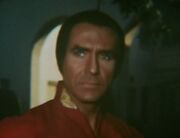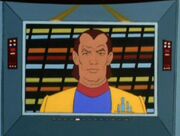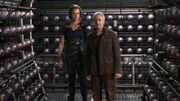Template:Disambiguate
"Superior ability breeds superior ambition."
The Eugenics Wars (or the Great Wars) were a series of conflicts fought on Earth between 1993 and 1996. The result of a scientific attempt to improve the Human race through selective breeding and genetic engineering, the wars devastated parts of Earth, by some estimates officially causing some 30 million deaths, and nearly plunging the planet into a new Dark Age. (TOS: "Space Seed"; ENT: "Borderland")
Prelude
Records from this period are fragmented, but what is known is that the wars' roots lie in a group of Human scientists' ambitious attempt to improve the race through selective breeding and genetic engineering. They created a race of "supermen," popularly known as the Augments, who were mentally and physically superior to ordinary men and women. They were five times stronger than the average person, their lung efficiency was 50 percent better than normal, and their intelligence was double that of normal Humans. They also had enhanced senses, including an ability to hear beyond that of Human capabilities. (TOS: "Space Seed"; ENT: "Borderland", "Cold Station 12")
One aspect these scientists overlooked was the personality of the Augments. Along with their superior abilities, the Augments were aggressive and arrogant; "flaws" which the scientists were unable to correct at the time, due to the infant stage of the science. One of the Augments' creators realized this, writing that "superior ability breeds superior ambition." That same scientist was ultimately killed by one of his own creations. (TOS: "Space Seed"; ENT: "Cold Station 12", "The Augments")
Rise to power

Khan Noonien Singh in the 1990s
The Augments rose to power and held dominance over a large portion of Humanity, beginning in the early 1990s. Among the most notorious of these superhuman conquerors was Khan Noonien Singh, who in 1992 became the "absolute ruler" of more than a quarter of the planet, from Asia through the Middle East. (TOS: "Space Seed")
The following year, a group of fellow "supermen" followed in Khan's footsteps, and simultaneously seized power in over 40 nations. Some people were treated as little more than slaves by the Augments. Khan considered himself a prince "with power over millions," and unlike some other nations ruled by Augments under his rule, there were no massacres and no wars of aggression until he was attacked; he was thus among the most admired of the so-called "tyrants" into the 23rd century, being called the "best of the tyrants" by James T. Kirk. (TOS: "Space Seed"; Star Trek II: The Wrath of Khan; ENT: "Borderland")
Conflicts
Reports as to exactly how the wars began vary; some claim that humanity rose up against Khan and his fellow "supermen," while others believe the Augments began to fight among themselves. Regardless of how they began, or who started them, the Eugenics Wars had a devastating impact on Earth, as entire populations were bombed out of existence. (ENT: "Cold Station 12"; TOS: "Space Seed") As the wars raged, and many areas were devastated, others (including those of the United States of America) remained largely unaffected. (VOY: "Future's End")
Among the areas affected by the wars was North Africa. One conflict that occurred there involved a battalion of soldiers that included the great-grandfather of future Starfleet Captain Jonathan Archer. In this encounter, Archer's great-grandfather was able to convince the commander of his enemy's forces to hold their fire long enough to evacuate a school that was directly between them. (ENT: "Hatchery")
The Augments were eventually defeated by Humans not genetically enhanced, with Khan being the last of the tyrants to be overthrown, in 1996. Over eighty of the "supermen" (including Khan) went unaccounted for, a fact the governments of the time did not disclose to the public in order to prevent panic. In 2267, it was discovered that Khan and 84 of his followers had managed to flee the planet unattended aboard the early sleeper ship SS Botany Bay. (TOS: "Space Seed"; Star Trek II: The Wrath of Khan)
The official number of casualties from the wars was placed at 30 million, although some historians believe it to be closer to 35 million, with another figure established as being 37 million. Although the wars may have ended, Humanity's fear of genetically-engineered beings remained well into the 24th century. (ENT: "Cold Station 12"; TOS: "Bread and Circuses"; DS9: "Doctor Bashir, I Presume")
Aftermath
Following the wars, controversial debates ensued between Earth's governments regarding the fate of thousands of Augment embryos. Uncertain of how to handle the issue, the governments opted to have the embryos placed into cryogenic suspension. This fact was also kept from public knowledge. (ENT: "Borderland", "Cold Station 12")
The issue of genetic manipulation and Human genome enhancement continued to plague Earth into the 21st century, proving to be one of the causes of further conflicts that ultimately erupted into World War III in 2026. (ENT: "In a Mirror, Darkly, Part II" historical archive) In the 23rd century, the Eugenics Wars themselves were sometimes viewed as synonymous with the Third World War, and possibly regarded as its initial cause, much like how the Second World War is often seen as a result of the First. (TOS: "Space Seed"; ENT: "In a Mirror, Darkly, Part II")

Doctor Keniclius

Soong and the Augment embryos
Genetic engineering of Humans was ultimately banned on Earth, as the concept was considered anti-Humanistic by Earth leaders. As a result of this, Doctor Stavos Keniclius was exiled from his community, which eventually led him to depart Earth permanently. The ban was placed primarily as an attempt to prevent another event like the Eugenics Wars, and to ensure that Humanity did not endure the wrath of another Khan Noonien Singh-type tyrant. (TAS: "The Infinite Vulcan"; DS9: "Doctor Bashir, I Presume", "Statistical Probabilities")
The ban on genetic engineering was challenged by the geneticist Arik Soong in the 2130s, when he stole some of the Augment embryos left over from the wars, which were being stored at Cold Station 12. Soong believed that genetic engineering was the key to improving Humankind and preventing illness, and that it should be given another chance. By raising the Augments himself, Soong believed he could prevent them from behaving like their brethren from the Eugenics Wars. His plan failed as the aggressive nature of the Augments took dominance, and they threatened to incite war and cause mass murder. Earth Starfleet's mission to hunt down and capture the renegade "supermen" ultimately led to the destruction of the Augments, as well as most of the embryos. (ENT: "Borderland", "Cold Station 12", "The Augments")
Not all of the embryos were destroyed, though. Some found their way into the hands of Klingons who, believing Humans were improving themselves in order to conquer the Klingon Empire, attempted to use the DNA from the embryos to enhance themselves. The end result was a mutation of a highly-contagious virus that caused massive changes in physical appearance, biological structure, and even basic personality traits of large portions of the Klingon race. (ENT: "Affliction", "Divergence")
Appendices
Related topics
Background
Both "Space Seed" and Star Trek II: The Wrath of Khan gave the dating of the Wars as the 1990s, but "Doctor Bashir, I Presume" was thought by some to have retconned that date with a reference to them having occurred two centuries prior to the events of that episode, placing the Wars in the mid-to-late 22nd century, which was inconsistent with Star Trek: First Contact. Episode writer Ronald D. Moore later admitted to having referred to the line from The Wrath of Khan, but accidentally forgot to account for the show being a century later. (AOL chat, 1997) The original dating of the wars was reaffirmed when Phlox stated in "Borderland" that Arik Soong's Augments were pretty sophisticated for 20th century genetics. Phlox later mentions to the Klingons that genetic engineering on Earth was "banned decades ago," likely meaning not more than a century ago; this could mean that genetic engineering was not banned until long after the Eugenics Wars, possibly after the formation of United Earth.
Also, in "Space Seed", Spock describes the Eugenics Wars as "the era of your last so-called world war," suggesting this conflict could be World War III. In TOS: "Bread and Circuses", it is stated by Spock that 37 million died in World War III – consistent with Phlox's assertion that over 30 million died in the Eugenics Wars (again connecting World War III and the Eugenics Wars) – but not Riker's claim that 600 million died in the nuclear conflict in the 2050s. As Spock was speaking in the context of despotism, and his numbers for WWI and WWII are not consistent with known total death-counts, the connection is less than conclusive. This is also possible given the enormous devastation a nuclear war is sure to have caused. In real life, the death tolls under Stalin, Mao, or Hitler have different numbers claimed, since records are so hazy. It would be doubly like this following a nuclear war.
Although TNG has never stated when World War III occurred until the movies, the problem is further complicated after further context established in TNG: "Up The Long Ladder". Data says that in the early 22nd century, they were still recovering from World War III. Given Riker's established end date of World War III as mid-21st century, and the continuation, even post-First Contact, of the post-atomic horror until at least 2079, it is not impossible to imagine that recovery from that massively devastating conflict might still be occurring in the early 2100s. Even TOS talks about wars in the early 21st century in TOS: "The Savage Curtain", indicating a potential link between the two conflicts through causal history in much the same way as World War I and World War II are linked by historians today.
Apocrypha
The Star Trek: The Eugenics Wars books portray a different view on the Eugenics Wars as being a more covert hidden battle between the genetically engineered "supermen" rather than an overt one in an attempt to marry the original dates of the Eugenics Wars with the events of the present day. It also raises the quite logical hypothesis that Gary Seven was involved in the overthrow of Khan and the other tyrants since he conceivably was present on Earth at the time of Khan's birth and would have known or seen the advent of the eugenics movement. Numerous 20th Century Trek characters appear in the story, including Rain Robinson (who at the end of the second book becomes Roberta Lincoln's assistant), Ralph Offenhouse (an early financial backer of the genetic engineering program), Clare Raymond (her death is not an embolism but collateral damage from a nerve gas attack, Khan's assassination of Vasily Hunyadi, the fellow Augment secretly behind the Balkan conflicts of the early 1990s), Gillian Taylor, Flint (as "Wilson Evergreen"), and Jeff Carlson, who designed the Botany Bay - with Shannon O'Donnell and Walter Nichols involved in the project - primarily with technology reverse-engineered from Quark's Treasure.
In "The Rules of War", a short story from the anthology Strange New Worlds 9, the enemy commander whom Archer's great-grandfather Nathan Archer negotiated with in North Africa is Stavos Keniclius.
Template:Earthwars
